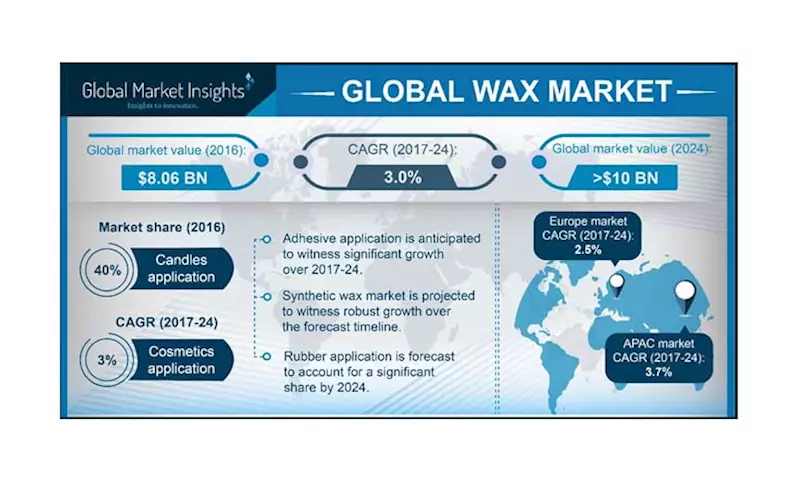Global wax market to exceed USD 10-billion by 2024
According to an industry report published by the Global Market Insights, the global wax market is set to surpass the USD 10-billion mark by 2024.
28 Aug 2019 | By Dibyajyoti Sarma
The application segment of wax market is subdivided into candles, packaging, rubber, adhesives, cosmetics, wood and fire-logs, among others. Of these, the packaging segment has received increased traction recently, primarily owing to its offered benefits in the food industry like water-loss prevention, extended storage life, halt shrinkage and spoilage.
The crux of business growth in recent times has been extensively attributed to the vast expanse of R&D programmes. The wax market, in this regard, has also been experiencing a transformation, given that as a long-in-existence organic compound, wax has found massive applications in numerous end-use domains.
A couple of years ago, for instance, a research group from the Colorado State University published a study related to edible superhydrophobic coatings from FDA-approved carnauba and beeswax for the food packaging domain. Traditional wax like beeswax or tallow wax and synthetic wax like paraffin wax have been a part of the wax market landscape since its inception. However, now, with the increasing scarcity of fossil fuels, hydrogenated vegetable wax has also marked its debut in this business space.
With the advancement of technology and increasing human endeavour for innovation, the wax industry share has depicted commendable progress through the product’s varied usage in packing, cosmetics and candle-making industries.
The wax industry has also receives significant stimulus through the use of wax in food packaging, since the product is an effective medium to create a protective barrier between food and deteriorating factors like moisture and humidity. It not only provides a preservative seal but also adds a glossy sheen on food items like fruits, nut seeds, and fertilisers. Wax coatings also help in delaying ripening, loss of internal moisture, and prolonging shelf life in general, thus expanding the scope of wax market share from food packaging.
The FDA has approved the use of wax as an edible coating to be safe, non-toxic, and hypo-allergenic. In response, wax is majorly used to coat whole fruits like avocados, mangoes, pomegranates, melons, apples, and papayas and as a glazing agent for nuts.
The candle-making industry has been one of the major and ancient drivers augmenting wax market size. While the traditional usage of candles as a chief source of light after sundown does not really exist anymore, the candle manufacturing sector still remains a multimillion dollar business. Aided by the presence of the internet and social media, the trend of manufacturing decorative and scented candles has taken shape, added a new dimension to the growth of the candle producing domain, which in consequence has impelled wax industry size from candle manufacturing.
With the evolution of myriad candle types, candle manufacturing has witnessed numerous changes over the centuries. At present, candle manufacturers not only use paraffin and fossil-based wax but also synthetic, bio-based and natural wax, which adds to the multi-dimensional growth of wax industry trends over the forecast period.
The cosmetics domain acts as a momentous driver transforming wax market outlook. In a world that is becoming increasingly obsessed with self-image and beauty, cosmetics sector is set to witness massive growth in next few years, a factor that will positively impact wax industry share over 2017-2024.
Rise in disposable incomes and an inclination toward beauty has spurred the demand for better skin and personal care products. Owing to drastically changing climatic conditions, consumers have also been demanding natural and eco-friendly cosmetics in the interest of health and environmental ramifications. These shifting trends, in consequence, will inevitably provide the much-needed boost to wax market expansion.
For details on the report, please visit Global Market Insights.











 See All
See All